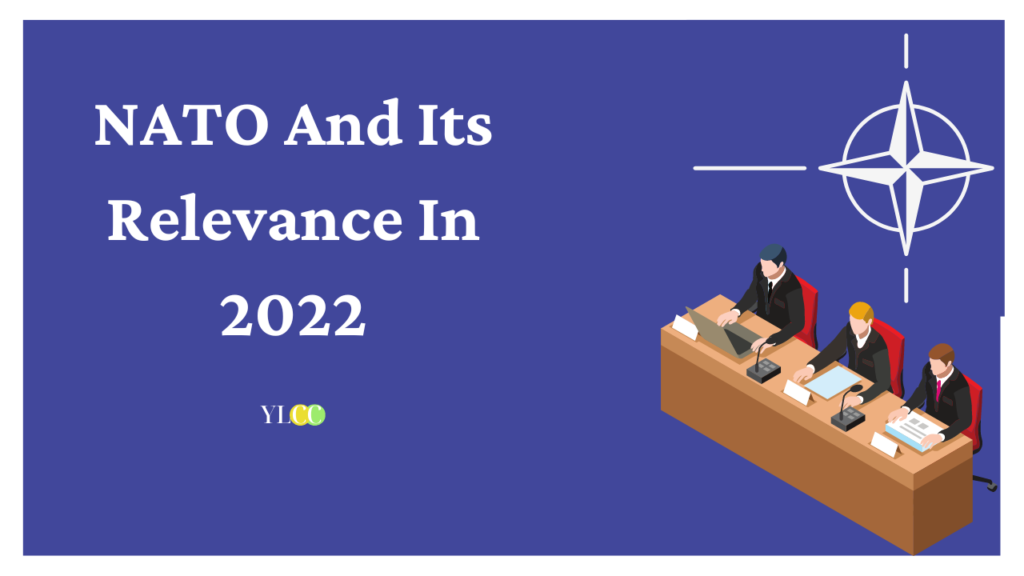
INTRODUCTION
The North Atlantic Treaty Organization (NATO), founded in the aftermath of World War II, is an intergovernmental military alliance comprised of 28 European countries and two North American countries, with its headquarters in Belgium. It implements the North Atlantic Treaty, a collective security system in which its member states agree to mutual defence in the event of an attack by any external party. Its mission is to protect the security and freedom of its member countries through political and military means. The other role of NATO is to protect common values such as democracy, individual liberty, the rule of law, and peaceful conflict resolution.
In this article, Team YLCC brings you an overview on NATO and its relevance in contemporary times. Read on!
FORMATION OF NATO
Western Europe was economically and militarily exhausted after World War II ended in 1945[1]. In the year 1948, The United States launched the Marshall Plan, which provided massive amounts of economic aid to countries in Western and Southern Europe on the condition that they cooperate with one another and engage in joint planning to expedite their mutual recovery. In terms of military recovery, the United Kingdom, France, and the Low Countries Belgium, the Netherlands, and Luxembourg agreed to form the Western European Union under the Brussels Treaty of 1948. However, it was soon discovered that a more formidable alliance was needed to provide a more adequate military counterweight to the Soviets.
Following a virtual communist coup in Czechoslovakia in February 1948, the three governments began talks in March 1948 on a multilateral collective-defence scheme that would strengthen Western security and promote democratic values. These discussions were eventually joined by France, the Low Countries, Norway, and the North Atlantic Treaty was signed in April 1949[2].
The deterioration of relations between the United States and the Soviet Union at the end of World War II eventually led to the Cold War. The Soviets wanted to expand its position in Europe by spreading communism, whereas the US saw the USSR’s ideology as a threat to its way of life. When the Cold War was heating up, the Soviet Union signed the Warsaw Pact, which included socialist republics from Central and Eastern Europe (1955). The Pact, which was primarily a political-military alliance, was seen as a direct strategic counterweight to NATO. Albania (which left in 1968), Bulgaria, Czechoslovakia, East Germany, Hungary, Poland, and Romania were all part of it. And after the dissolution of the Soviet Union, the Pact was officially disbanded in early 1991.
POST COLD WAR SITUATION
NATO was reconceived after the Cold War as a cooperative-security organisation with two primary goals:
- To encourage dialogue and cooperation with former Warsaw Pact adversaries
- To manage conflicts on Europe’s periphery
With the dissolution of the Warsaw Pact in 1991, NATO lost its de facto main adversary. This prompted a strategic re-evaluation of NATO’s purpose, nature, and tasks. NATO’s first post-Cold War expansion occurred with the reunification of Germany on 3 October 1990, when former East Germany became part of the Federal Republic of Germany and the alliance. In order to achieve the goals, NATO formed the North Atlantic Cooperation Council in 1991, which was later replaced by the Euro-Atlantic Partnership Council, as well as the Partnership for Peace programme in 1994 to strengthen European stability and security through joint military training missions with NATO and non-NATO states, including former Soviet republics and allies. Special cooperative ties have also been established with two partnership for Peace nations: Russia and Ukraine. NATO’s first large-scale military engagement occurred on March 24, 1999, when it launched an 11-week bombing campaign against the Federal Republic of Yugoslavia. The conflict ended on June 11, 1999, when Yugoslavian leader Slobodan Miloevi agreed to NATO’s demands by accepting UN Resolution 1244. NATO’s activities and geographical reach expanded even further as a result of the September 11 attacks[3].
ROLE OF NATO IN WORLD AFFAIRS
Russia-Ukraine Conflict:
Tensions along Ukraine’s border with Russia are at an all-time high. Fearing a Russian invasion, the United States and NATO increased their support for Ukraine. The Soviet Union developed communist ideology, while the United States of America promoted capitalist ideology. In terms of goal and purpose, both ideologies are diametrically opposed. Despite the fact that neither Ukraine nor Russia are NATO members, NATO is still thought to be behind the crisis. The organization is an important player in the ongoing war with Russia[4]. NATO expresses its support for the Ukrainian public and government. Allies support Ukraine’s sovereignty and territorial integrity within internationally recognized borders. NATO will continue to provide Ukraine with strong political support, as well as equipment to assist Ukraine in self-defense and ongoing financial support. NATO strongly condemns Russia’s vicious and unprompted war against Ukraine, an independent, peaceful, and democratic country that is also a close NATO partner. The Alliance urges President Putin to immediately end the conflict, withdraw all of his forces from Ukraine, and engage in genuine diplomacy.
Resolute Support Mission in Afghanistan :
Following the completion of the International Security Assistance Force mission, the NATO-led Resolute Support Mission (RSM) in Afghanistan was launched on January 1, 2015. Resolute Support was a non-combatant NATO mission. The mission was established at the Afghan government’s request and in accordance with UN Security Council Resolution 2189 of 2014. Its goal was to assist Afghan security forces and institutions in developing long-term ability to safeguard Afghanistan and protect its citizens. A Status of Forces Agreement (SOFA) signed by the Afghan President and NATO’s Senior Civilian Representative to Afghanistan in November 2014 established the legal framework for RSM. The SOFA outlined the terms & conditions under which NATO forces were deployed in Afghanistan as role of Resolute Support, as well as the activities that they were tasked with carrying out under this agreement. The US and the Taliban signed an agreement in February 2020 to withdraw international forces from Afghanistan by May 2021.Recognizing that there is no military solution to Afghanistan’s problems, the Allies decided on 14 April 2021 to begin withdrawing RSM forces by 1 May 2021. Early in September 2021, the mission was terminated[5].
NATO Mission Iraq :
NATO Mission Iraq (NMI) is a non-combat advisory and capacity-building mission that aided Iraq in developing more sustainable, transparent, inclusive, and effective security institutions and armed forces so that Iraqis can stabilize their country, fight terrorism, and prevent the return of Daesh. Following a request from the Iraq government, the mission was launched at the NATO Summit in Brussels in July 2018 and established in October 2018. NMI advises Iraq’s Ministry of Defence, the National Security Advisor’s Office, the Prime Minister’s National Operations Centre, and national security education institutions on how to build more sustainable, transparent, inclusive, and effective defensive institutions and structures. The mission provides guidance on the rule of law, armed conflict law, combating corruption, civilian protection, children and armed conflict, and the Women, Peace, and Security agenda. It is based on collaboration and inclusivity, as well as complete respect for Iraq’s sovereignty, independence, and territorial integrity.
THE FUTURE OF NATO
The North Atlantic Treaty Organization (NATO) is a major international organisation. Every member country, big or small, has an equal voice in issues and decisions. Individual freedom, democracy, human rights, and the rule of law are values shared by all member countries. These values are central to NATO’s transatlantic relationship. NATO’s ability to constantly adapt is one of the secrets to its longevity. The scope and diversity of NATO operations and missions have grown significantly since the 1990s[6]. NATO’s mandate now includes out-of-area crisis management operations, cooperative security partnerships with non-NATO partners around the world, training and capacity building efforts in Africa and the Middle East, and strategies to manage threats such as cyber and disinformation that are intentionally below the level of armed conflict. Terrorism, piracy, the proliferation of weapons of mass destruction, and cyber warfare have no borders and are spreading rapidly. NATO has built a vast network of security partners that includes over 40 countries and international organisations such as the United Nations, the European Union, the Organization for Security and Cooperation in Europe (OSCE), and the African Union. NATO will undoubtedly contribute to the reduction of these global threats. Consider a world without NATO for a moment. What borders might be challenged, and what ethnic conflicts might erupt in Europe if NATO and a strong US commitment to Europe did not exist? And how diminished would the United States’ global power and influence be without the support of its allies? NATO has been an answer to these questions for many years. It must be fit for purpose if it is to remain the answer for many years.
CONCLUSION
NATO’s transformation is not complete. It is a continuous process of adaptation and reform aimed at facilitating NATO to effectively deal with new global security challenges. Despite these ongoing changes, NATO’s basic tenets will remain the same: the principle that nations can only ensure their security by cooperating, and, most importantly, the principle that Europe and North America are a distinctive community of shared values and interests. Based on these core rules, NATO will continue to play an important role as an effective crisis manager and a solid framework for global security cooperation.
[1] Olsen, J. A. (2020). Understanding NATO.The RUSI Journal, 165(3), 60–72. https://doi.org/10.1080/03071847.2020.1777772
[2] Masters, J. (2014). The North Atlantic Treaty Organization (NATO).Council on Foreign Relations.
[3] Rühle, M. (2013). Reflections on 9/11: A View from NATO. Palgrave Macmillan, 54–66. https://doi.org/10.1057/9780230391222_3
[4] Wolff, A.T. (2015). The future of NATO enlargement after the Ukraine crisis. International Affairs (Royal Institute of International Affairs 1944).91(5).1103–1121. http://www.jstor.org/stable/24539021
[5] Auerswald, D. P., & Saideman, S. M. (2014). NATO in Afghanistan : Fighting Together, Fighting Alone. New Jersey: Princeton University Press.
[6] North Atlantic Treaty Organization. (1981). The North Atlantic Treaty Organization, facts and figures. Brussels: NATO Information Service.
YLCC would like to thank Dipti Tharwani for her valuable contribution in this article.






